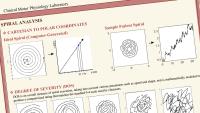Research

Current Projects
Spiral analysis normative data study (SANDS)
The purpose of this study is to determine detailed normative characteristics, properties, reliability, and utility of the graphonomic Spiral Analysis program. Over 200 healthy control subjects, ranging in age from 20 to over 90 years were asked to draw spirals on a graphics tablet attached to a computer both under standard conditions, and with and without visual feedback, and over 50 indices have been collected and analyzed.
Validation of spiral analysis in early Parkinson’s disease
In collaboration with Dr. Rachel Saunders-Pullman of the Beth Israel Medical Center and Albert Einstein College of Medicine, we are performing a longitudinal study of patients identified with early Parkinson’s disease. This study investigates the correlation between a standard clinical rating scale (Unified Parkinson’s Disease Rating Scale) and spiral indices with the goal of evaluating spiral analysis as a tool for quantifying clinical and sub-clinical motor control issues in Parkinson’s disease.
Evaluation of the efficacy of botulinum toxin in the treatment of focal dystonia in musicians
Musician’s Dystonia is one of the focal occupational conditions characterized by involuntary muscle spasms, abnormal postures and movements, tremors, and pain that can seriously impede a musician’s ability to play, or even continue a professional career. The goal of this project is to use analysis of digitized musical performance to assess changes in dystonic symptoms before and after treatment with botulinum toxin Type B (Myobloc, Solstice Neurosciences, Inc.).
Analysis of fine motor control in pre and post-operative deep brain stimulator (DBS) implant patients
Computerized analysis of freely drawn spirals is used to quantify improvements following DBS surgery for patients with essential tremors and Parkinson’s disease. In addition to a pre to post-comparison of the standard indices generated by the program, the hypothesis that Parkinson’s patients are particularly dependent on visuomotor control and external cue is being tested.
Physiological, clinical, and epidemiological investigations of essential tremor and related disorders
In collaboration with Dr. Elan Louis, the CMPL performs computerized physiological testing on patients with essential tremor and related disorders in population-based and other types of epidemiological studies. The overall goals are to help establish diagnoses in affected people and family members, quantify baseline status and post-treatment effects, and clarify subtle or unique motor control phenomena. Recent work has focused on the quantification of cerebellar dysfunction and special kinematic issues related to tremor.
Digital analysis of facial affect in patients with Parkinson’s disease
In collaboration with Dr. David Forrest from the Department of Psychiatry, we are developing an automatic method to determine and quantify abnormal facial expressions and changes in emotional profiles – based on real-time video imaging. The effects of treatment and the progression of disease are monitored. Affect, change in mood, and emotion are among the most unique attributes of human interaction and are conveyed through facial expressions. Applying this to computerized facial measurements, we are trying to note dynamic changes in emotion and expression.
Clinical biomarkers for amyotrophic lateral sclerosis (ALS)
In collaboration with the Lou Gehrig MDA/ALS Center, the CMPL has been participating in this multi-modality study of ALS by providing Transcranial Magnetic Stimulation (TMS) to patients suffering from ALS at three-month intervals over one to two years. TMS helps in the detection of upper motor neuron involvement and, in conjunction with other tests, helps predict and track the progression of disease. Patient enrollment is currently complete.